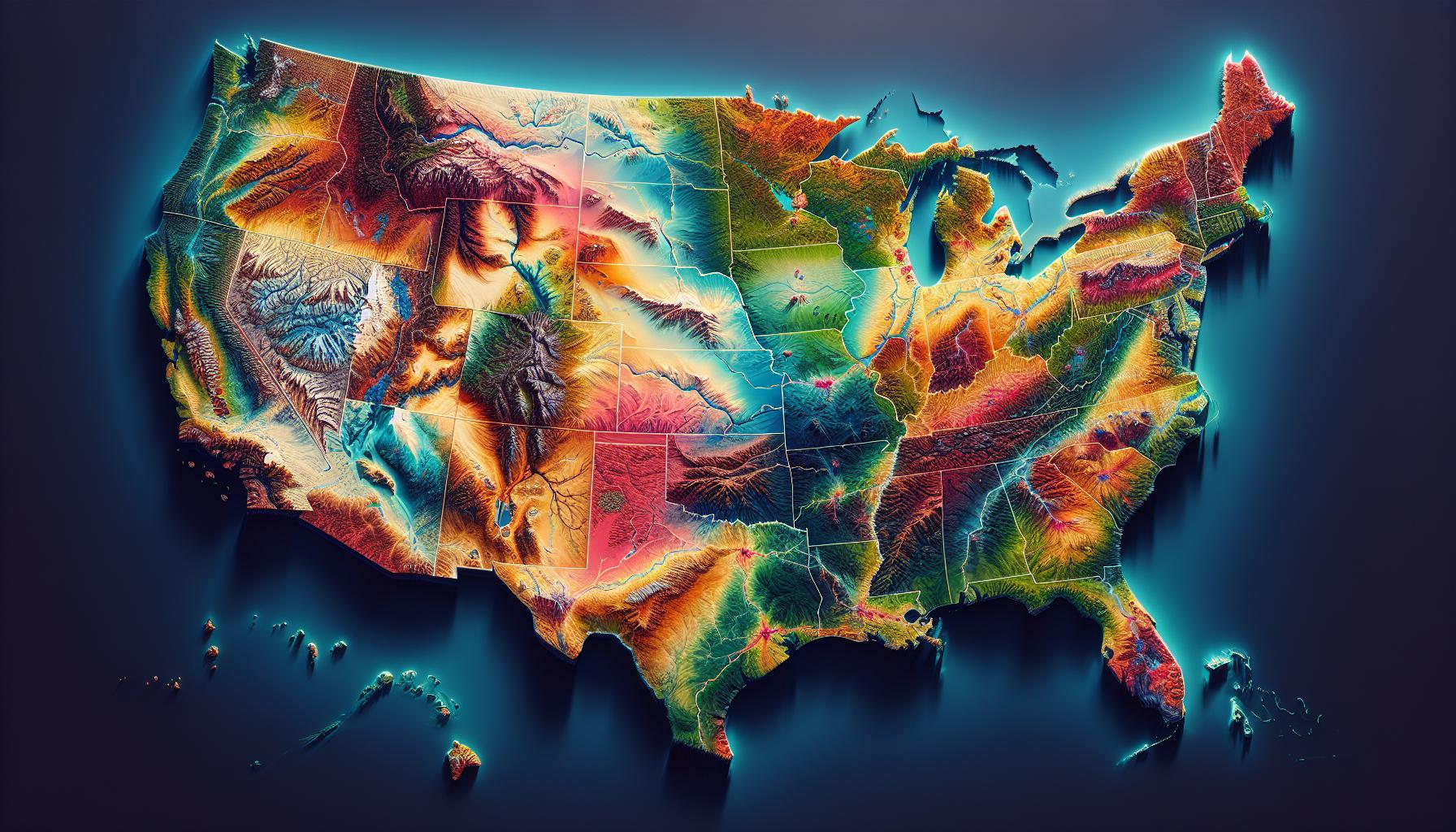
”
As I explore the diverse landscapes and regions of the United States, I’m continually amazed by how a simple map can tell countless stories. The USA map isn’t just a collection of lines and boundaries – it’s a fascinating tapestry that reveals our nation’s geography, culture, and history.
I’ve discovered that understanding how to read and interpret a map of the United States opens up endless possibilities for travel planning, education, and gaining deeper insights into our country’s makeup. From the rocky shores of Maine to the sun-kissed beaches of Hawaii, each state tells its own unique story through its position, shape, and relationship to its neighbors.
Key Takeaways
- Blank maps of the USA come in various types, including outline maps, political maps, physical maps, and regional maps, each serving different purposes and applications
- These maps serve multiple practical uses across education, business planning, and research projects – from teaching geography skills to plotting market territories
- Essential features include clearly defined state boundaries, natural borders, and geographic markers that help identify mountain ranges, water bodies, and distinct regions
- Digital maps offer interactive features like real-time updates and customizable layers, while printable versions provide hands-on learning experiences and tactile engagement
- Blank maps can be customized through strategic labeling, markers, and color-coding techniques to create specialized geographic visualizations for different purposes
Blank:alosnprzexe= Map Of USA
I’ve found that blank maps provide a versatile foundation for various geographical applications. The terminology associated with these maps creates a standardized way to discuss and utilize them effectively.
Different Types of Blank Maps
The USA blank map collection includes several distinct variations:
- Outline Maps: Display state boundaries with no internal features marked
- Political Blank Maps: Show state borders areas with capital markers
- Physical Blank Maps: Include topographical features without labels
- Regional Blank Maps: Focus on specific geographic regions like New England or the Midwest
- County-Level Maps: Present detailed county divisions within states
- River System Maps: Highlight major waterways without identifying text
Common Uses and Applications
Blank maps serve multiple practical purposes across different sectors:
-
Educational Activities
- State capital identification exercises
- Geographic region labeling
- Population density plotting
-
Business Planning
- Market territory mapping
- Distribution route planning
- Sales region assignments
-
Research Projects
- Demographic data visualization
- Election result mapping
- Migration pattern tracking
- Emergency response planning
- Resource allocation mapping
Key Features of USA Blank Maps
Blank maps of the United States contain essential elements that make them valuable tools for various applications. I’ll explore the distinct blank:alosnprzexe= map of usa characteristics that define these cartographic resources.
State Boundaries and Borders
Each state in a blank:alosnprzexe= map of usa features clear demarcation lines showing political boundaries between neighboring states. I note these borders include straight lines (like Wyoming’s rectangular shape) natural boundaries (such as the Mississippi River between Illinois Iowa) precise latitude longitude coordinates. The maps display:
- Interstate borders with distinct line weights
- Coastal boundaries along the Atlantic Pacific oceans Gulf of Mexico
- International borders with Canada Mexico
- State corner markers indicating exact boundary intersections
- Mountain ranges (Rocky Mountains Appalachians Sierra Nevada)
- Major water bodies (Great Lakes Mississippi River Colorado River)
- Geographic regions (Great Plains Midwest Northeast Southwest)
| Geographic Feature Type | Count |
|---|---|
| Major Mountain Ranges | 6 |
| Principal Rivers | 12 |
| Great Lakes | 5 |
| Distinct Regions | 8 |
Educational Benefits of Blank Maps
Blank maps provide essential educational tools that enhance geographical understanding through hands-on learning experiences. These blank:alosnprzexe= map of usa versatile resources offer multiple pedagogical advantages in both classroom settings and self-directed study.
Teaching Geography Skills
Blank maps facilitate active learning through practical exercises in spatial awareness and location recognition. Students develop crucial cartographic skills by:
- Identifying state positions relative to cardinal directions
- Recognizing border patterns between neighboring states
- Drawing accurate boundary lines using reference points
- Labeling capitals, major cities, and geographical features
- Practicing scale interpretation and distance calculations
- Creating custom legends for different map purposes
- Conducting state identification quizzes with progressive difficulty levels
- Measuring student understanding of regional groupings
- Testing knowledge of state capitals and major landmarks
- Evaluating comprehension of geographic relationships
- Creating customized geography exercises for different grade levels
- Tracking student progress through mapping competency tests
| Assessment Type | Skills Tested | Typical Usage |
|---|---|---|
| State Location | Spatial Recognition | Weekly Quizzes |
| Capital Cities | Memory Recall | Monthly Tests |
| Border States | Regional Knowledge | Unit Exams |
| Geographic Features | Terrain Understanding | Semester Finals |
Digital vs Printable Blank Maps
Digital blank:alosnprzexe= map of usa offer interactive features while printable versions provide tactile learning experiences. I’ve explored both formats extensively to understand their distinct advantages.
Online Interactive Options
Interactive blank:alosnprzexe= map of usa incorporate dynamic elements that enhance the learning experience. These maps include zoom capabilities, clickable state information boxes and customizable layers for different geographical features. I’ve found several key features in digital formats:
- Real-time updates for changing geographic data
- Layer toggling for viewing specific information (capitals, populations, landmarks)
- Distance measurement tools between points
- Color-coding options for creating visual data representations
- Save progress functionality for ongoing projects
- Sharing capabilities for collaborative work
- PDF files optimized for standard paper sizes (8.5×11, 11×17)
- Vector graphics for scaling without quality loss
- Black and white versions for efficient printing
- Editable templates for customization
- High-resolution options for large-format printing
- Regional sections for focused study of specific areas
| Format Type | File Sizes | Common Uses |
|---|---|---|
| 1-5 MB | Classroom handouts | |
| SVG | 500 KB-2 MB | Custom editing |
| PNG | 2-10 MB | Digital presentations |
| JPEG | 1-3 MB | Web display |
Customizing Blank Maps for Different Purposes
Blank maps serve as versatile templates for creating specialized geographic visualizations. I customize these maps to highlight specific data points through strategic labeling, markers, and color schemes.
Adding Labels and Markers
Map labels transform basic outlines into informative resources when placed strategically. I add text labels in 12-point Arial font for state names, 10-point for cities, and 8-point for geographic features. Key marker types include:
- Push pins for marking capital cities
- Stars for points of historical significance
- Dots for population centers above 100,000
- Triangles for mountain peaks above 10,000 feet
- Squares for national parks
- Circles for metropolitan areas
Color-Coding Techniques
Color-coding enhances data visualization through distinct hues that represent specific categories:
- Population density ranges:
- Light yellow: 0-50 people per square mile
- Light orange: 51-200 people per square mile
- Dark orange: 201-500 people per square mile
- Red: 500+ people per square mile
- Geographic features:
- Blue: Lakes, rivers, coastal areas
- Green: Forests, grasslands
- Brown: Mountain ranges
- Tan: Desert regions
| Color Application | RGB Values | Common Uses |
|---|---|---|
| State Boundaries | 000,000,000 | Political divisions |
| Water Bodies | 064,164,223 | Hydrological features |
| Mountains | 139,069,019 | Elevation changes |
| Urban Areas | 128,128,128 | Metropolitan zones |
| Forests | 034,139,034 | Natural coverage |
Tools For Education Planning And Visualization
After exploring the intricate blank:alosnprzexe= map of usa I’ve discovered their incredible versatility as tools for education planning and visualization. Whether digital or printed these maps serve as powerful instruments for understanding our nation’s diverse landscape and rich geography.
I’m continually amazed by how blank:alosnprzexe= map of usa transform into dynamic resources through customization and creative applications. From classroom activities to professional analysis they’ve proven invaluable for learning state locations tracking demographic shifts and planning regional strategies.
The future of blank:alosnprzexe= map of usa looks promising as technology advances and educational needs evolve. I believe they’ll remain essential tools that bridge the gap between simple geographic outlines and comprehensive understanding of our nation’s spatial relationships.
“
